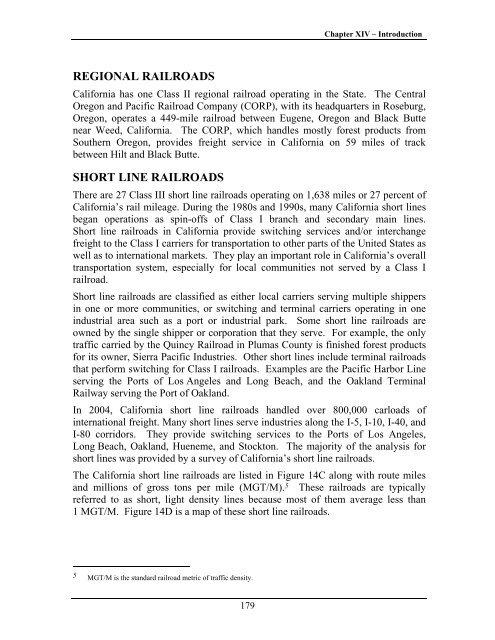California State Rail Plan 2005-06 to 2015-16
California State Rail Plan 2005-06 to 2015-16
California State Rail Plan 2005-06 to 2015-16
You also want an ePaper? Increase the reach of your titles
YUMPU automatically turns print PDFs into web optimized ePapers that Google loves.
Chapter XIV – Introduction<br />
REGIONAL RAILROADS<br />
<strong>California</strong> has one Class II regional railroad operating in the <strong>State</strong>. The Central<br />
Oregon and Pacific <strong>Rail</strong>road Company (CORP), with its headquarters in Roseburg,<br />
Oregon, operates a 449-mile railroad between Eugene, Oregon and Black Butte<br />
near Weed, <strong>California</strong>. The CORP, which handles mostly forest products from<br />
Southern Oregon, provides freight service in <strong>California</strong> on 59 miles of track<br />
between Hilt and Black Butte.<br />
SHORT LINE RAILROADS<br />
There are 27 Class III short line railroads operating on 1,638 miles or 27 percent of<br />
<strong>California</strong>’s rail mileage. During the 1980s and 1990s, many <strong>California</strong> short lines<br />
began operations as spin-offs of Class I branch and secondary main lines.<br />
Short line railroads in <strong>California</strong> provide switching services and/or interchange<br />
freight <strong>to</strong> the Class I carriers for transportation <strong>to</strong> other parts of the United <strong>State</strong>s as<br />
well as <strong>to</strong> international markets. They play an important role in <strong>California</strong>’s overall<br />
transportation system, especially for local communities not served by a Class I<br />
railroad.<br />
Short line railroads are classified as either local carriers serving multiple shippers<br />
in one or more communities, or switching and terminal carriers operating in one<br />
industrial area such as a port or industrial park. Some short line railroads are<br />
owned by the single shipper or corporation that they serve. For example, the only<br />
traffic carried by the Quincy <strong>Rail</strong>road in Plumas County is finished forest products<br />
for its owner, Sierra Pacific Industries. Other short lines include terminal railroads<br />
that perform switching for Class I railroads. Examples are the Pacific Harbor Line<br />
serving the Ports of Los Angeles and Long Beach, and the Oakland Terminal<br />
<strong>Rail</strong>way serving the Port of Oakland.<br />
In 2004, <strong>California</strong> short line railroads handled over 800,000 carloads of<br />
international freight. Many short lines serve industries along the I-5, I-10, I-40, and<br />
I-80 corridors. They provide switching services <strong>to</strong> the Ports of Los Angeles,<br />
Long Beach, Oakland, Hueneme, and S<strong>to</strong>ck<strong>to</strong>n. The majority of the analysis for<br />
short lines was provided by a survey of <strong>California</strong>’s short line railroads.<br />
The <strong>California</strong> short line railroads are listed in Figure 14C along with route miles<br />
and millions of gross <strong>to</strong>ns per mile (MGT/M). 5 These railroads are typically<br />
referred <strong>to</strong> as short, light density lines because most of them average less than<br />
1 MGT/M. Figure 14D is a map of these short line railroads.<br />
5 MGT/M is the standard railroad metric of traffic density.<br />
179













